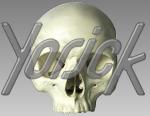
 |
 |
 |
 |
 |
 |
 |
 |
 |
3.10.5 slice3 interface
The slice3 function, in contrast, makes planar slices or isosurface contours of functions of three variables. You can pseudocolor the planar slices, or show projections of the isosurfaces, or combine slices with isosurfaces. The plfp function makes the actual plots, but you call a higher level function, pl3tree.
Unlike plwf, you must invoke at least two functions in order to plot anything. First, you call to slice3 returns either a planar slice through your 3D data, or an isosurface of some scalar function on your 3D mesh. Next, you call pl3tree in order to add the slice or isosurface to your 3D display list.
Again, Yorick's pseudocolor model does not permit partially transparent surfaces. Often, you need to slice open closed isosurfaces like a melon in order to view the interior. Use the slice2 and slice2x functions to make slices like this. Unfortunately, when you remove slices to make interior surfaces visible, you will only be able to see through your slice from a restricted range of viewing directions. That is, the best slicing planes will depend on your viewing direction. Study the `demo5.i' for an example of how to make this type of picture.
A trick allows you to both color your slices (like a 2D plf or pli), and shade your isosurfaces, despite the limitations of the pseudocolor model. The idea is to split your palette into a gray scale you can use to shade isosurfaces, followed by a color palette you can use to pseudocolor slices. The split_palette routine in `slice3.i' generates such a split palette. Again, read `demo5.i' for details.